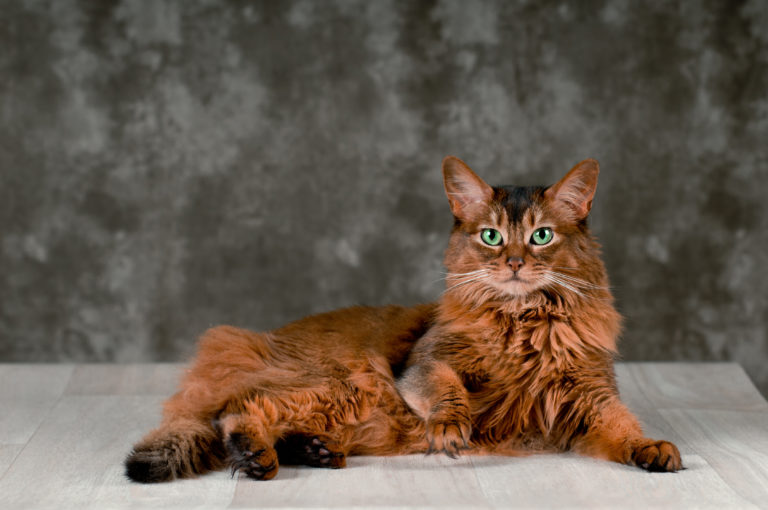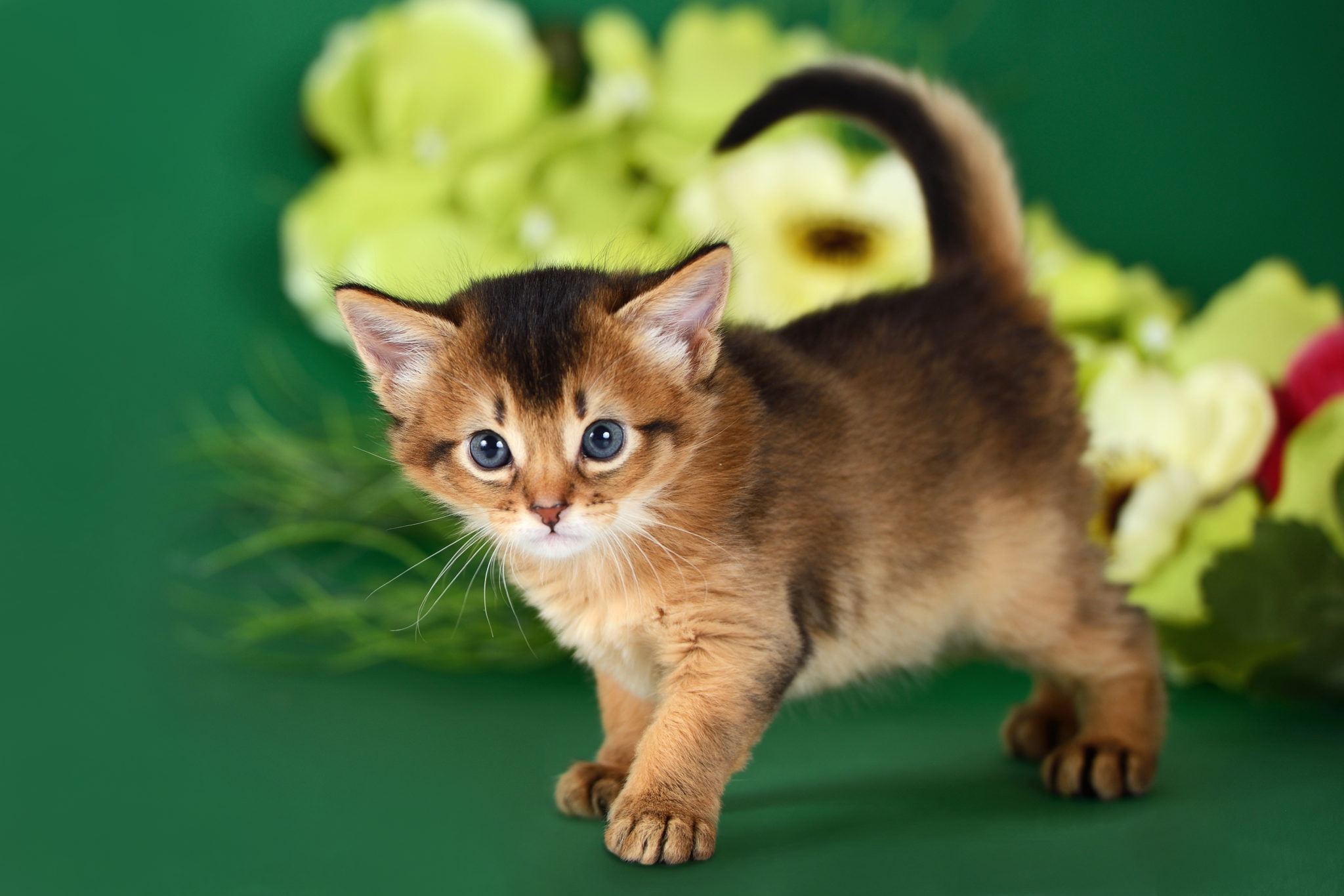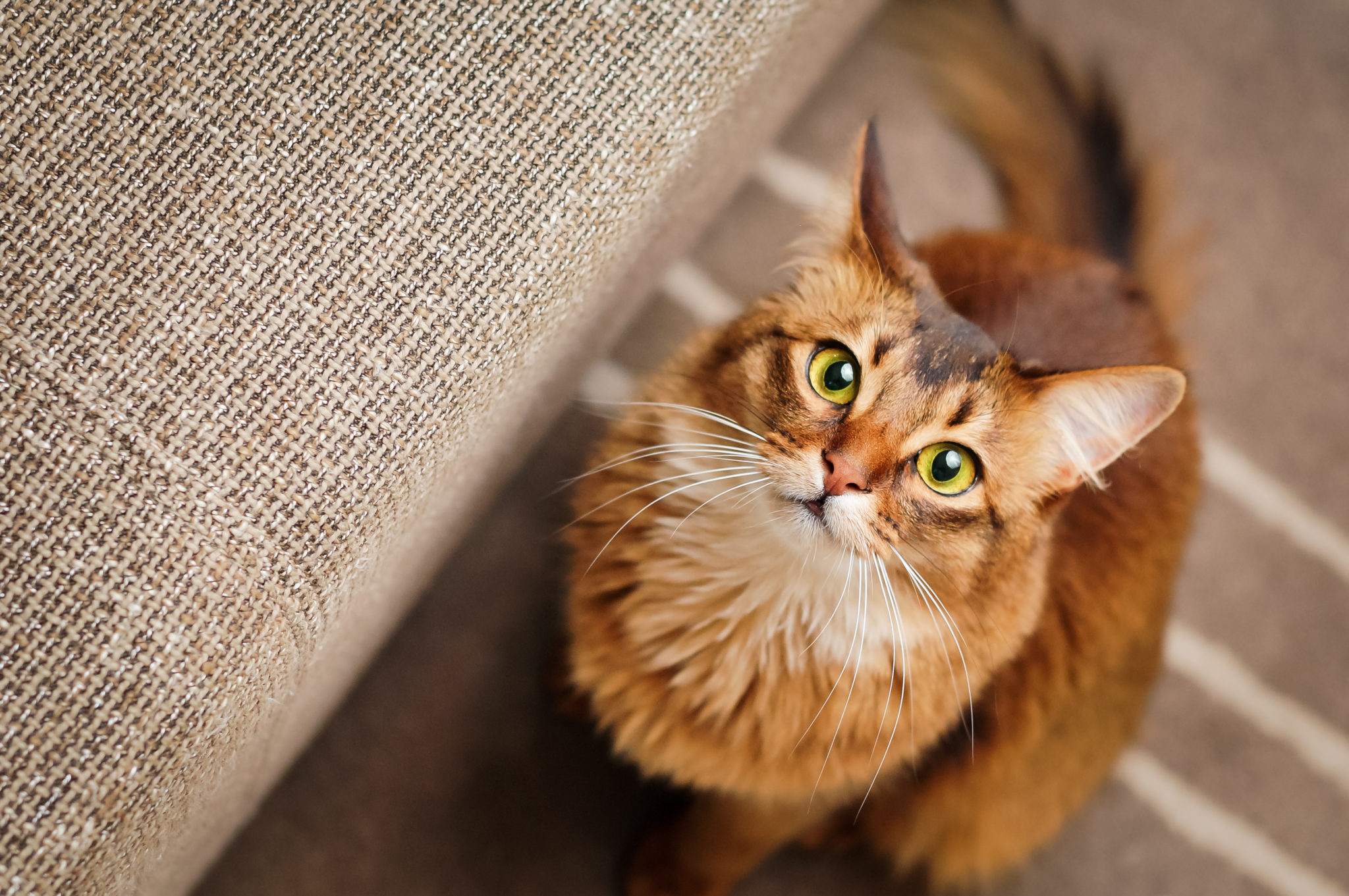Maine Coon
The Maine Coon has now become one of the most popular cat breeds in the world and is enjoying increasing popularity in Ireland, too. This is probably thanks to its authenticity, robustness and excellent character.
If you love Abyssinian cats but would prefer a feline friend slightly longer hair, then the Somali cat could be right up your street!

© GrasePhoto / stock.adobe.com
The Somali cat is a variant of the Abyssinian cat, but with longer hair. Aside from this disparity in fur length, there are no differences between the two and the breeding standards are the same for both varieties.
Although the two share this breeding standard, the Abyssinian is often described as a miniature puma, while the Somali is less “plushy” than its sister breed. The Somali is just as slim and long-legged as the Abyssinian and is also of medium size, with females weighing up to 4kg and males a little more at 5kg. As with many oriental cat breeds, these athletic Somali cats have long legs ending in small, oval-shaped paws with single-coloured pads. The tail has a wide base and is very bushy, whilst the neck is delicate and graceful.
A Somali cat’s head is very striking, thanks to its large, wide eyes and ears, which give the cat an attentive expression. The amber, light brown or green eyes are large and almond-shaped with a clear border. The head itself is wedge-shaped with smooth contours.
The medium-length hair of the Somali cat has very little undercoat and is extremely fine. It is nevertheless soft and people generally prefer this cat to have a well-developed ruff of hair around its neck. Around the shoulders, the fur is much shorter. As with Abyssinians, Somalis often have dark coloured stripes along their backs. These begin between the shoulders and end at the tip of the tail. Many Somalis also have a so-called “sole stripe” that runs along the hind legs to the heel.
The colouring of Somali cats can also be particularly striking and is known as “ticking”. This means that each hair contains two, three or even four bands of colour, with the darkest colouring at the tip. Interestingly, only certain areas of the body have ticked hairs, in particular the head, back, tail and outside of the legs. In contrast, the underbelly, chest and inside of the legs are all a uniform base colour.
Although Somalis and Abyssinians show signs of their colouring from around six weeks old, it is only at about two years that the final colour will come through. After this, the pattern develops and the colouring resembles that of a wild rabbit, which is known as the “agouti effect”.
The breed standard for both Abyssinians and Somalis only allows colourings with a brown base. These colour pigments promote strong light absorption and dark pigmentation. Breeding allows just four different colours types: usual (also known as ruddy), sorrel, blue and fawn.
Usual: This is the original colouring of Somali cats and a warm brown. The base colour is a dark apricot or orange and has black ticking. All other colours come from this usual colouring, which can also be known as ruddy or tawny.
Blue: This does not necessarily refer to the colour blue, but more to different intensities in a blue-grey shade. This blue colouring actually comes from the usual colouring, caused by a mutation of the gene that causes the intensity of the colour. Blue Somali cats are a warm blue-grey, with individual hairs in dark steel-blue-grey ticking.
Sorrel: Not to be confused with the actual red colouring, this describes Somalis with warm, cinnamon colourings and chocolate brown ticking. It comes from a mutation of the gene for the colour black.
Fawn: Fawn is a diluted form of sorrel, with a light cream base colour and warm, cream ticking, combined with a pink muzzle.
Some Somali cats appear in other colours that are not yet recognised by breeding standards. These include chocolate and its diluted form, lilac.
 © nelik / stock.adobe.com
© nelik / stock.adobe.com
Somali cats are lively and intelligent, as with many other oriental breeds. They are particularly inquisitive, following their owners wherever they go and always wanting to get involved with everything. This inherent curiosity means that toys, particularly those that test intelligence, are joyfully received.
This breed of cat has a high drive when it comes to movement, meaning that it is not necessarily suitable for being kept permanently indoors. This is particularly true if it will be a single-cat household, as Somalis and Abyssinians are social pets that do not like to be left alone. They will devote themselves wholly to their owners, but it is only with another cat that they find a truly valuable companion. When on the hunt for the perfect partner for your Somali, bear in mind that it is a particularly dominant breed of cat. In many cases, a sibling from the same litter will make the perfect life-long companion, as they have been used to each other since birth.
There is a long-haired gene present in many short-haired breeds, but it is often concealed. This means that long-haired cats will always show up from time to time in the Abyssinian breed, which is where the Somali breed originated from. Initially, they were deemed unfit for breeding, but from 1967 onwards they have been specifically bred, particularly in the USA. In order to distinguish this new breed from the Abyssinians, they were named “Somalis” after Somalia, the neighbouring country to former Abyssinia, now known as Ethiopia.
This choice of name is particularly interesting, as Abyssinians do not, as their name suggests, come from Abyssinia, modern-day Ethiopia. Nor, as the myths claim, are the Abyssinians the descendants of those cats living in ancient pharaonic Egypt and worshipped as divine beings. In actual fact, the Abyssinian, the sister breed of the Somali, is thought to come from Southeast Asia, something which can be corroborated by findings in the Abyssinian genes. This breed is the only one to present a mutation of the tabby-cat genes, giving it the name “Abyssinian Tabby”, and it is something that is found in neither Egypt nor East Africa. Instead, it is found to have come from cats along the coast of the Indian Ocean between Singapore and Sri Lanka. Images of cats from a 19th century English cat journal show cats very similar to the Abyssinian, which were described as “Asiatic cats”. It is thought that English owners brought the ticked, usual cats to the Near East, East Africa and Europe.
The modern breeding of Abyssinians and Somalis began in the 19th century in England. The striking “agouti” markings of a cat “from Abyssinia” drew a great deal of attention. It is probable that this cat came to England with British troops, who returned from East Africa in 1868. Just a few years later in 1871, an “Abyssinian cat” was presented at the Crystal Palace. By 1882, the breed had been officially recognised. It is said that the racial standard for the Abyssinian was set by Harrison Fair himself, the president of the British national cat club at the time. Shortly afterwards, the new breed could also be found in the USA and in 1911 it was officially established as a cat breed by the Cat Fanciers’ Association (CFA). In 1933, the first Abyssinian cats were also registered in Germany.
The number of Abyssinian cats reduced drastically during the two world wars, although this was a fate that also fell to a number of other cat breeds. In the case of the Abyssinian, it also resulted in the relatively small litter size – the majority of cats will produce a litter of between one and four kittens, whereas the Abyssinian is more likely to produce just two. In the 1960s, an epidemic of feline leukaemia led to further decimation of the breed. Although the Abyssinian population has been protected since the 1970s, it is still in no way as well-preserved as other better-known cat breeds.
Since the 1950s, long-haired Abyssinians have continued to appear in litters, most commonly in England. At this point it has not yet been explained how the long-haired gene came to be present in the gene-pool of this breed, although it is suspected that it was a result of crossing foreign breeds shortly after the world wars. Either that, or it is the result of an independent mutation. In order to find a clear answer to this question, the Somali Cat Club of America carried out investigations during the 1970s into all known pedigree lines of the breed, during which it was noted that all lines could be traced back to a single Abyssinian stud. This cat was found to have originated in England then sold to an owner in the USA. It must have been predisposed to long hair, a characteristic that it has passed on to all of its descendants.
The Somali cat comes from the continued targeted breeding of these long-haired varieties, which began to be bred selectively by breeders in the 1960s. The first official Somali cat litter was born in the USA in 1972, with the breed being officially recognised in 1979 by the forming of the Somali Cat Club of America (SCCA). This group was set up as the umbrella organisation for all breeders of the Somali cat. 1982 heralded the arrival of the largest European umbrella organisation. According to breeding standards, the Somali cat must be bred purely, with the only possible exception being the Abyssinian cat. Any kittens resulting from this pairing are known as an “Abyssinian Variant” and are a form of Abyssinian carrying the recessive gene for long fur. As long hair is not a desired characteristic in Abyssinian breeding, these variants are primarily used in Somali breeding instead.
The breeding of Somali cats follows the strict breed standards of each umbrella organisation. For those breeding in Europe, the Fédération Internationale Féline is responsible for this standard, whilst in the USA the Cat Fanciers’ Association and The International Cat Association are amongst the larger umbrella organisations in charge. Although small, there are slight differences between the breeding standards upheld by these large organisations.
 © lounom / stock.adobe.com
© lounom / stock.adobe.com
The Somali is generally an uncomplicated cat breed, requiring no particular breed-specific care. The medium-length hair is fairly easy to care for thanks to the small amount of undercoat. This means that the Somali must only be combed or brushed around once a week.
To help keep your Somali healthy and happy, a high-quality cat food with plenty of protein is always a good idea and a great investment. As carnivores, cats gain the majority of necessary nutrients and protein from top quality meat and can only make use of small amounts of carbohydrate.
Naturally, it is also vital to take your cat for an annual check up with the veterinarian, especially if your playful Somali enjoys a great deal of freedom. Here you can discuss any possible health problems, as well as getting valuable advice regarding necessary vaccinations and pest control.
Although the Somali has not been over-bred and is a fairly select breed, it still suffers from a predisposition to certain illnesses, just like its sister breed. One of these predispositions is for “feline neonatal isoerythrolysis” (FNI), a rare blood disorder in which the mother cat’s blood group and that of her kitten are incompatible, thanks to a particular combination of the three blood groups, A, B and AB. This is caused by a previous breeding of an A blood group cat with a B blood group cat. Once the kittens are born, they drink their mother’s milk containing antibodies against blood group B. This leads to excessive excretion of haemoglobin, which can result in acute anaemia. FNI is always fatal, but can be avoided by breeders ensuring they know the blood groups of their cats and pairing them accordingly.
Retinal diseases such as progressive retinal atrophy (PRA) are also common in Abyssinians and Somali cats. Night blindness is often the first symptom of this disease, which causes the eye’s retina to be destroyed by local metabolic disorders in the tissue. The degenerative form of this illness is inherited by recession and can cause problems with vision from as early on as the second year of life, although it can take up until the sixth year for the disease to make itself known. If you are breeding cats, it is compulsory for your pets to undergo regular examinations by trained veterinarians. DNA tests are still being developed to check for this disease.
Somali cats can also be susceptible to pyruvate kinase deficiency, an inherited metabolic disorder of the pyruvate kinase enzyme that can affect the survival of red blood cells and reduce their lifespan. There is no real treatment for this disease, although blood transfusions can help extend your cat’s life expectancy. This disease is another that is transmitted recessively, with the carriers rarely suffering from the deficiency. However, if two carriers of this recessive gene are bred together, the kittens are almost certain to suffer from this lack of vital pyruvate kinase enzymes.
Hereditary diseases such as those mentioned above once again highlight the importance of responsible, well-informed breeding. A reputable and trustworthy breeder will put his name to the health of his animals and their young, taking responsibility for having his pets regularly checked for hereditary diseases such as PRA, breeding his cats carefully in order to avoid FNI and ensuring the kittens always end up in safe hands, often with a protective contract in place. For the initial weeks and months after handing the kittens over to their new owners, he will be on hand with advice and support, as well as giving them the vaccination passport and results of any examinations the cat may have undergone. Breeding cats costs a great deal of both time and money, including high-quality food for both mother and kitten, veterinary costs, vaccinations, potential worming treatments and membership costs for official breeding clubs. Everything adds up, and this is not even including the extensive time cost from the numerous hours a breeder will devote to being there for his animals.
This, of course, means that the kittens themselves will cost any potential owner a fair amount of money. The Abyssinian is a very rare cat breed, with its long-haired Somali cat cousin being rarer still. One of these cats as a pet may cost upwards of £600, with a breeding cat costing substantially more.
Anyone looking to offer a Somali cat a home must be prepared to pay a relatively high price, especially if you are looking to take home more than just one. Alternatively, cats that are no longer fit for breeding can often be taken on at a much lower cost. Or what about your local animal shelter? Plenty of long- and short-haired felines will be looking for a loving new home and, who knows, you might just find your dream cat!
We wish you a lifetime of happiness with your Somali cat!
The Maine Coon has now become one of the most popular cat breeds in the world and is enjoying increasing popularity in Ireland, too. This is probably thanks to its authenticity, robustness and excellent character.
Neva Masquerade – a mysterious name for a mysterious thing of beauty! The Neva Masquerade is the point variation on the Siberian cat and shares many characteristics with this breed.